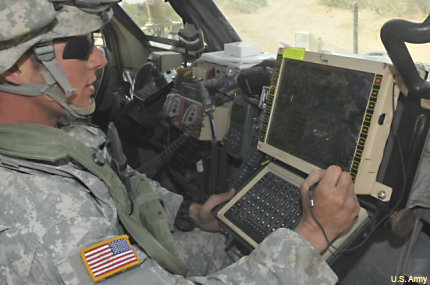Army takes the next step on Force 2025 tactical system
Teams at Fort Bliss complete the latest tests of WIN-T Increment 2, bringing real-time battlefield intelligence to the company level.

A soldier accesses the network from inside an MRAP vehicle at Fort Bliss.
The Army’s efforts to have real-time tactical information flow down to soldiers in the field took another step forward recently, as the Brigade Modernization Command finished up the latest test of the services evolving battlefield network, Warfighter Information Network-Tactical, Increment 2.
During Network Integration Evaluation 15.1, the eighth of the Army’s semi-annual field tests of the network, 3,900 Soldiers and 1,200 government employees spent a month at Fort Bliss, Texas, testing equipment in a variety of terrains and scenarios. Increment 1 of WIN-T, used in Iraq and Afghanistan, extended voice, video and data communications to the battalion level. Increment 2 takes real-time intelligence down to the company level, which covers three to four platoons and 100 to 200 soldiers.
The eventual goal for WIN-T, part of the Army’s Force 2025 initiative, is to extend the command-and-control operational picture down to the squad level and even individual soldiers.
Each of the NIE exercises has focused on developing different aspects of the network, incorporating feedback from soldiers to work on improvements. One emphasis of NIE 15.1, which ran from Oct. 3 to Nov. 4, was seeing how new equipment that had undergone developmental testing functioned outside of a laboratory, in the diverse terrain around Fort Bliss.
"When you put things out in the field, and you get a rain storm, or the wind blows 20 or 30 knots, or it gets in the heat, it performs differently," Col. Jim Crider, deputy commander of the Brigade Modernization Command, said in a release. "This area is more than just desert. There's undulating terrain, high mountains, narrow and wide passes ... all of which makes this an ideal location to conduct evaluations."
Another focus for Increment 2, or WIN-T2, is improving interoperability and ease of use. WIN-T2’s computer systems and radios are intended to work with those of other services—as demonstrated in the Joint Staff’s multinational Bold Quest exercises. And the Army has said before that it wants the tactical mobile network to be, as much as possible, as familiar and intuitive to soldiers as the smartphones they grew up with and use in their personal lives. The easier the system is to use, the more soldiers can concentrate on the mission at hand.
"The promise of NIE is the ability to bring all those systems together in a seamless way, where the operator can really focus on the fight, and not fight the systems," said Brig. Gen. Timothy Coffin, commanding general of White Sands Missile Range, N.M., which hosts a lot of NIE testing. "We don't want to add burden onto the soldier or the commander. We want to allow them to focus their intelligence and their efforts into fighting the adversary."
Through the NIE exercises, which started in 2011, and feedback on deployed iterations in Iraq and Afghanistan, the Army has worked on steady, incremental improvements. WIN-T2 was first deployed in in 2012, and while it extended the range of the network, it also increased the network complexity, boosting the number of nodes fourfold. Among other things, the Army has since worked on streamlining the network by reducing the number of individual systems used, from about 70 in 2011 to about 20 this year.
Increment 3, which is being developed and tested, will bring architecture changes designed to boost capacity while extending on-the-move communications further down the chain.



